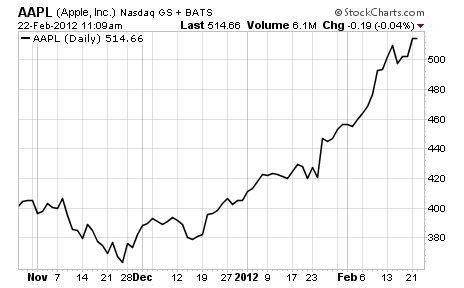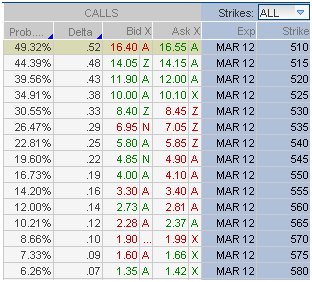The most basic requirement for successful trading is to have some well-defined strategy, or in other words, a specific approach that gives you an edge.
That approach could be buying undervalued securities and selling overvalued securities, or it could be some better-than-breakeven way of selecting price-directional trades.
Without such a strategy or edge, you will eventually lose, because the odds of success are 50/50 before transaction costs. And if you don’t know what your method is, you don’t have one.
Which is why I trade credit spreads.
It gives me a defined edge and it allows me to choose my own probability of success. For example, take the hottest stock on the planet right now – Apple (NASDAQ: AAPL).

I can buy or sell the stock short right now, but my probability of success would be only 50%. The stock is going to go either up or down. Including my transaction costs, my probability of success is actually lower than 50%. Plus, at more than 500 bucks per share, I’d have to fork over a lot of capital to make the trade.
However, through the use of credit spreads – more specifically selling vertical spreads – I can choose a much greater probability of success and lower my capital requirement.
Just look at the options chain for AAPL below.

If you have access to theoretical options pricing on your trading software, you can look at the probability of expiring in the money (far left column) for the most accurate probability of success. If not, you can use delta as it’s the next best approximation tool.
I often get the question, "So how does this probability thing work anyway?"
Take the Mar12 530 call, which has a 69.5% chance of expiring out of the money (100% – 30.55%). The Mar12 540 calls have an even higher probability of expiring worthless at roughly 77% (100% – 22.8%).
The more a call strike is above the current price of the underlying stock, the greater the probability that the call option will close out of the money, and therefore expire worthless. And that’s the ideal scenario when selling options – you want the option to expire worthless so that you retain the premium collected up front.
Basically, I am selling options to speculators – traders, most likely newbies, who are speculating that Apple will continue to surge past the 530 strike by March options expiration (22 days). The trade they have chosen to make has a probability of success of 30.55%. Those are odds that I would never take as a trader.
So let’s say I decided to place a bear call spread at the 530/535 strike – selling the 530 and buying the 535 (to keep my risk defined) for a credit of $1.35, or $135 per contract. Note that I’m selling the 530 call at the bid price of $8.40 and buying the 535 call at the ask price of $7.05.
The break-even point for this trade is $531.35 ($530 + $1.35 credit). Thus, Apple stock would have to move 4.0% higher before March expiration for the trade to be in jeopardy of taking a loss. So I could be completely wrong in my assumption of Apple moving lower and yet I can still make a profit.
Why aren’t more and more investors using this strategy? It makes perfect mathematical sense. You get to choose your own odds based on the risk/return that you feel most comfortable with in your trading portfolio.
This is what I do in the Options Advantage service and it is what I have been doing throughout my entire career as an options trader.
I am still amazed how many still insist on listening to talking heads or anyone for that matter on what stock to buy. Jim Cramer is entertaining, but he never attaches odds to his picks. More importantly, he never gives you a time frame for his picks. Just the picks, which unfortunately is a very small part of investing.
Knowing that each and every stock choice has only 50/50 odds of success, it just doesn’t make sense that people keep perpetuating the guessing game that goes on daily in the investment world. Stop guessing and start using probabilities to make your decisions.
Consider paper trading the idea above. I know you’ll learn something. Remember, feel free to email me at [email protected] with any questions that you might have regarding options.
Kindest,
Andy Crowder
Editor and Chief Options Strategist
Options Advantage and The Strike Price
Wyatt Investment Research
 Facebook
Facebook
 Twitter
Twitter